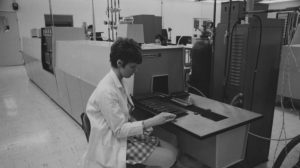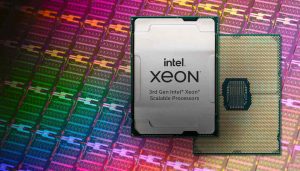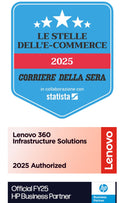Intel, the company that builds the brains of our computers
Heart and brain of our personal computers and technological devices, Intel's presence is predominant in the world of information technology. Since its foundation, Intel has "filled" the market with processors , chips, motherboards and much more, thanks to a process of continuous improvement. But how did it all start?
Intel, first steps of an empire 
Intel was born from the intuition of two experts, already introduced in the sector, who understood that a new niche was opening up. These visionaries are Robert Noyce and Gordon Moore (that's right, the one with the law of the same name which says that the complexity of a microcircuit doubles every 18 months) who in 1968 left Fairchild Semiconductors to found the Integrated Electronics Corporation. High-sounding name which will soon after be shortened to the current and successful INTEL.
The two initial partners, purely technical, then add a third, Andrew Grove, who will manage the company, taking care of the financial and commercial side. A winning trio, which will lead Intel to supply, first components for memories and then complete memories (such as DRAM, SRAM and SROM).
Intel would then become what we currently know only in 1971, the year in which four engineers, including the Italian Federico Faggin, gave birth to the first microprocessor, the Intel 4004 .
A product that immediately achieved clear success, also confirmed by a sales volume of 66 million dollars in revenues.
From memories to microprocessors
Once again it is Andy Grove who decides the course for the future; this happened in 1983, when the president of the board of directors decided to completely abandon the first business, that of memories, to totally dedicate the company resources to the production and implementation of microprocessors.
This choice was pushed by Grove and the entire CDA by the market, in the form of IBM, at that time the largest producer of personal computers in the world, which decided that it needed a dual source of production for its microprocessors.
The primary production source was identified as Intel , through the 8086 processor. The other supplier was identified as AMD (Advanced Micro Devices), which from that moment became Intel's historical competitor.
Growth continues and Intel's technology laboratories, the IALs (Intel Architecture Labs), become the major innovators in personal computer hardware. The IALs present and introduce the USB port, the PCI communication bus and its evolution PCI Express and the first architectures for multiprocessor servers.

Intel and AMD, a complex relationship
Collaborations and clashes with AMD begin long before IBM's joint supply. In fact, the brands began their "collaboration" in 1976, with an agreement that allows them to use the technology patented by the competitor without the need to pay or even inform the other party.
The Pentium generation
The processor was born in the 90s that would change the balance of power between the two companies. In fact, Intel presents the Pentium family which will monopolize the processor market, also leading Intel to clash with the antitrust for its dominant (if not exclusive) position on the market.
Not just PCs
The long-term collaboration with the manufacturer IBM does not stop Intel from trying to work with Apple too. This collaboration led to the creation of the first iMac in 2006. Collaboration that will continue uninterruptedly until 2020.
Intel, patents and antitrust
When working in the field of technological and IT innovation it is quite common to clash with the competition. When the product created is revolutionary and achieves immediate and predominant success, the clash with the antitrust is just around the corner.
Intel has obviously clashed many times over the years in the patent and market fields, with mixed results:
Acquisitions and partnerships
Intel's structure is very active regarding acquisitions and collaborations. In fact, over the years, many other shareholdings and joint ventures have been added to the first joint ventures with IBM, partly AMD and Apple.
In 2007, Intel acquired Havok, a software developer famous for developing a physics engine that is used in many games.
In 2008, Intel teamed up with STMicroelectronics and Francisco Partners to create Numonyx, a Swiss-based company dedicated to the production of non-volatile semiconductor memories (NOR and NAND).
Intel intelligently sought collaborations that would allow it to broaden its field of action. An interesting new niche approached by Intel was in fact that of drones. Intel has looked in particular at two areas in this new sector:
The entry into these two new niches occurred thanks to partnerships with the leading companies in this sector. In the field of high definition cameras, an agreement has in fact been signed with Qualcomm. As regards processors for drones, agreements have been drawn up with DJI and Ryze Robotics.
Despite growth in numerous niches, microprocessors are still Intel's dominant market.
This is demonstrated very simply by seeing the features and models presented by Intel itself, in an escalation of performance and computing power.

Intel processor history
It all started in 1971 , with the 4004 processor, universally recognized as the first processor in history.
Following, from the same range and with the same basic characteristics (4-bit or 8-bit processor), the 4040, 8008, 8080 and 8085 appear.
But the evolution continues and the first leap occurs immediately afterwards, with 16-bit processors. This evolution will lead to the creation of the architecture called X86 which will be the basis of processors that will make the history of computing.
In fact, this series includes the 8086, 8088, 80186, 80188 and 80286.
The transition to 32-bit processors is now imminent.
32bit X86 processors, the platform called IA-32
The 32-bit processors are divided into two different categories, those belonging to the 386 range and the 486 ones. The evolution of these two will then lead to the release of the future Pentium series.
Pentium series
Fortunate series of processors produced from 1993 to 1999 is considered to be the fifth generation of the x86 architecture.
In fact, this series includes Pentium, Pentium MMX, Pentium II, Pentium III and two series called Pentium Extreme Edition.
The continuous improvement of processors also leads Intel for the first time to differentiate them between the "normal" range and the "economic" range, a division that will remain over time.
This second series will then be called Celeron , for a process of economic differentiation that will continue for each new type of processor both in the PC sector and for mobile devices.
Core, the post Pentium
After more than ten years of presence of the Pentium series, it was enriched by the launch of the Core series, which began in 2006 with the Core2Duo.
The Core series is the first in which Intel produces a single series of processors for different types of machines. The Core is in fact designed for both desktop and mobile devices.
Despite the unification of the machines, however, the division by price range continues, with the Dual Core version both as Pentium and Celeron destined for the economic range.
Another step forward occurs with the new generation, which based on the Nehalem architecture begins to take a name composed of a letter and a number.
Core iX series
Thus the Core i3, i5, i7 and i7 Extreme were born. For a new series still on the market at the current date.
Not just desktop processors 
Intel doesn't just make processors for desktop computers. In fact, despite having unified some product lines (there is no longer any distinction between personal computers and notebooks ), Intel's processors dedicated to specific sectors continue to be present in various forms.
Mobile processors
The “mobile hardware” sector has seen notable development in recent years. An improvement in performance and miniaturization of the devices also corresponds to a new series of processors.
In the field of processors for mobile devices, Intel's evolution has been continuous and has followed that carried out for PCs. Intel entered this market with the Pentium range, and then launched the Core range, the Core 2 and the Core iX.
Also for this "niche" Pentium has created an economical processor, called Celeron M.
Server and workstation processors
Not only end users, but also professional systems. In fact, Intel's proposal covers all sectors where processing capacity is required. In the server and workstation field, Pentium has in fact launched the Pentium Pro series, the Pentium II Overdrive and the entire Xeon series over the years.
Ultrabook processors
Among computers, only ultrabooks have maintained a differentiation from other PCs. For this series of miniaturized and optimized computers Intel has in fact created the Atom and A1X0 series.
However, Intel is not only active in the field of computers and smartphones; processors are in fact now part of many electronic devices and for them (from TVs to washing machines, but also many other types) Intel has created two series of processors. The one called Canmore and the one known as Sodaville.
Intel computer processors currently on the market
As already indicated previously, in the field of processors for personal computers, those currently on the market are only those of the Intel Core iX series. But what are the differences between the various numbers?
Let's look at them, starting from the "lower" ones:
Intel Core i3
Twelfth generation of Intel family processors, the i3 series covers the demands of the economic range. In fact, within this category we find processors with a number of cores ranging from 2 to 8, a maximum frequency of approximately 4.1 GHz and a maximum cache of 12 Mb. These processors also support 11th Generation Intel UHD integrated graphics.
Intelligent systems, equipped with all the essential features and perfect for general daily needs.
Intel Core i5
Further development of the twelfth generation of processors, for components designed for more demanding uses, such as 4K graphics for example. In fact, this category includes processors with maximum turbo frequencies of 4.40 Ghz for devices equipped with a cache of up to 18 Mb. The graphics features are also top-notch with support for UHD mode.
Intel Core i7
Power up to 8 cores for demanding computing tasks . All this and much more is present in the i7 family. In fact, it is a family of processors that supports up to 12 cores, for a maximum turbo frequency that can reach up to almost 5 Ghz.
Technologically advanced solutions, for machines designed for demanding uses, both from a computational and graphic point of view.
Intel Core i9
Further evolution for a series of chips that stops at nothing, thanks to the 16 active cores. This computing power allows you to work with 4K Video in Ultra-HD. The perfect component for gaming computers and those who do video editing, this processor has a maximum turbo frequency above 5 GHz and a cache of up to 30 Mb. The graphics sector is obviously top level.
Intel Core X Series
The ultimate in CPUs, with the possibility of having up to 18 cores for unlimited performance. Very high base and maximum processor frequency are combined with more than 20 Mb of cache for very high level performance, such as that required by extreme gaming and the creation of very high resolution video content.
Intel and the evolution of computing
There are few companies that can say they have been witnesses and architects of the IT evolution of the last 30 years. From a hardware point of view, Intel is certainly one of these, for a company that, thanks also to continuous innovation, aims to be a leader in the future. In fact, Intel's evolution has never stopped, with the company aiming to remain a leader in the future also in the IoT (Internet of Things) sector, the new frontier of Internet 4.0).









